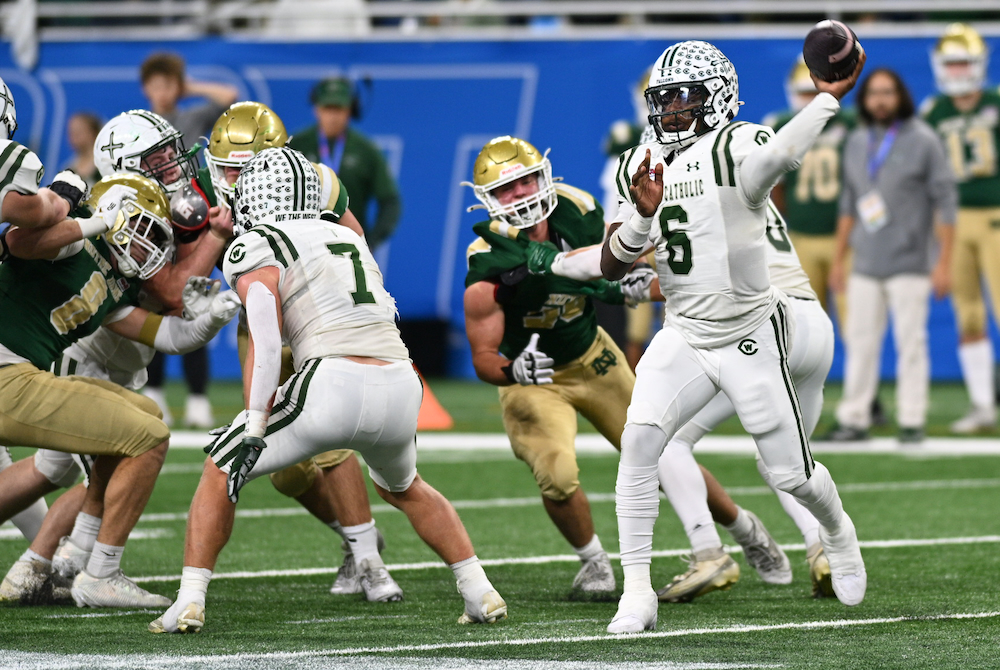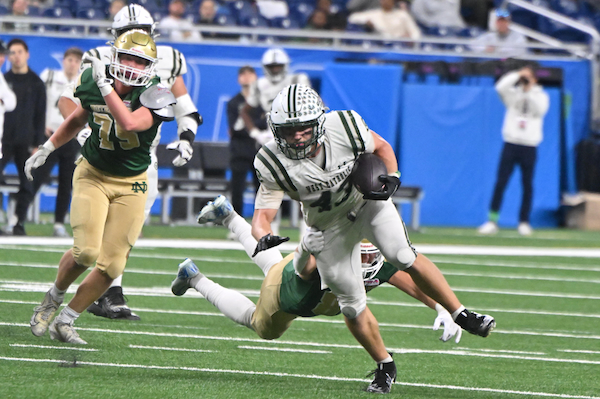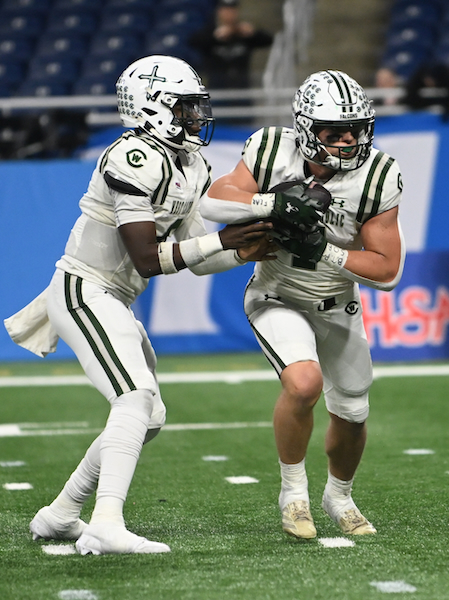
Michigan’s Football Numbers Game – Corrected
September 1, 2017
Today’s blog was written by MHSAA Second Half Editor Geoff Kimmerly
The demise of Michigan high school football has been greatly exaggerated – or, at least, recently misreported by one of the U.S.’s most recognizable newspapers that noted as part of a larger story on football decline that Michigan has seen a “net loss of 57 teams in the past five years.”
It’s easy to understand how this error took place – especially when a reporter is not familiar with the football landscape in our state – but that doesn’t make this statement any less misleading, or harmful considering the story since has been picked up by multiple large news organizations. So let’s quickly clear up the misinterpreted information:
-
The data that led to this error came from an annual participation report released by the National Federation of State High School Associations (NFHS). Every spring, state associations (like the MHSAA) from every state and Washington, D.C., tally up how many of their member schools have a sport and how many athletes play it.
-
For 2016-17, the MHSAA submitted to the NFHS a total of 580 schools with 11-player football – that number actually includes all schools that reported having at least one football player, including primary and secondary schools in co-ops. And yes, that 580 is 57 fewer than the 637 11-player schools the MHSAA submitted for 2012-13.
-
But saying Michigan has lost 57 football programs misses out on something incredibly significant – the MHSAA also submitted 60 schools with 8-player football last year, up from 16 in 2012-13, making that net decrease in football schools over five years 13 – far fewer than 57.
And with a few more brush strokes, the picture of football in our state actually shows a healthy landscape:
-
The 640 schools in Michigan with at least one football player for 2016-17, 11 and 8-player combined, is actually eight more than we reported to the NFHS four years ago and 10 more than three years ago.
-
A better picture of Michigan’s football consistency is shown by how many varsity programs are taking the field. This fall, that number is 616 – 555 11-player varsities and 61 8-player – and we also had 616 for most of the 2016 season, 616 in 2015 and 615 in 2014.
-
We’ve had programs bring back varsity teams this year, and in one case a school has a team on its own for the first time. Benzonia Benzie Central and Suttons Bay were unable to field varsities in 2016, but Benzie Central is back playing 11-player and Suttons Bay is back with an 8-player team. Brimley, an 8-player school going back to 2010, also is fielding a team again after being unable to do so last year. Mount Clemens played only two varsity games in 2016 and forfeited a third, but has seven scheduled for this fall and lost close in its opener last week. And Bear Lake, previously a secondary school in a co-op program, now has a team all its own for the first time and is playing at the 8-player level.
-
Yes, there has been a decrease in Michigan high school football participation when it comes to the number of players – for reasons we discuss frequently, including more extracurricular/entertainment options than ever for students, more who are specializing in other sports and safety fears that often are misplaced. But we’ve also seen a three percent drop in enrollment at MHSAA member schools over the last five years. And despite that trend, Michigan again had the sixth-highest 11-player football participation in the nation in 2016-17 (and seventh-highest in 8-player) while ranking 10th nationally in number of residents of high school age.
-
So yes, while a nine percent drop in the number of football players over the last five years in Michigan clearly is troubling, and something we’re working with the Michigan High School Football Coaches Association to reverse, let’s also put those numbers in perspective. At medium-sized to bigger schools, it could mean a roster of 40 might have only 36 players. A roster of 20 at an 8-player school might go down to 18. Neither would signal the need to eliminate a football program.
-
And that move by so many schools to 8-player? It definitely started as a way for low-participation programs to keep football (and has worked for most of them). While that still may be the driving force as schools move from 11 to 8, others have made the switch because most of their former opponents did and joining them makes scheduling easier and travel shorter. Michigan has a multitude of small towns, and you’ll find most of these 8-player programs in pockets in the thumb, southwest or northern Lower Peninsula, or Upper Peninsula. And keep in mind, only Class D teams remain eligible for the 8-player playoffs – and only two of 61 teams playing 8-player this fall are larger than Class D and its enrollment limit of 203 students for 2017-18.
The story behind “a decrease of 57 schools” clearly is a little complex to explain and explain away, but it’s necessary to do so.
Yes, Michigan’s total number of football players is down a few percent. But the sport’s prominence and importance in our schools and communities remains high.

Driven to Dominate, West Catholic Dethrones 2024 Champ to Reign Again
By
Scott DeCamp
Special for MHSAA.com
November 30, 2025
DETROIT – The 2024 season didn’t finish the way that Grand Rapids West Catholic’s football team had intended. The 2025 season didn’t begin the way the Falcons would’ve hoped.
At the end of the day, two defining defeats and other adversities along the way set the stage and helped the 2025 squad peak at the right time.
West Catholic proved as strong as it’s been all season, and then some, in a 42-14 victory over Pontiac Notre Dame Prep in the Division 5 Final on Sunday at Ford Field. The title was the Falcons’ first since 2022, their eighth in program history, and it marked the seventh-straight Finals appearance in which they’ve emerged victorious.
“Unbelievably proud of the way we played. It was one of those things where we knew we had that type of potential in us,” fourth-year West Catholic coach Landon Grove said.
“It’s been an up-and-down season with a lot of variables with injuries. We had a lot of injuries pile up each week, but they never flinched. The amount of adversity we faced this year – we lost captains, we lost underclassmen starters, upperclassmen starters – and it was just a next-man-up mentality.”
West Catholic (13-1) opened the season with a 32-21 loss to Grand Rapids Northview, then ripped off 13 straight victories.
The most momentous win along the way was a 21-20 overtime triumph in its District Final at archrival Grand Rapids Catholic Central, which had ended West Catholic’s 2024 season with a 21-18 defeat. GRCC also had ended West Catholic’s 2023 season in their Regional Final in another tight matchup, 30-28.
 Once they returned to the Finals on Sunday, the Falcons left no doubt. They made plays all over the field, starting with senior quarterback Grady Augustyn’s 79-yard strike to junior Thomas Puksta to put their team on top, 7-0, just 4½ minutes into the contest.
Once they returned to the Finals on Sunday, the Falcons left no doubt. They made plays all over the field, starting with senior quarterback Grady Augustyn’s 79-yard strike to junior Thomas Puksta to put their team on top, 7-0, just 4½ minutes into the contest.
West Catholic worked with short fields the rest of the first half, thanks to its stingy defense, and the Falcons stretched the lead to 28-0 midway through the second quarter on the following plays: a one-yard TD run by Augustyn (with 2:30 left in the first quarter), senior Connor Olszewski’s three-yard scoring run (10:34 left in the second), and Puksta’s 25-yard TD reception from Augustyn (5:54 left in the half).
“It feels great just to do it with this class. Our class has been working its butts off this whole year, last year,” said Augustyn, who finished 9-of-18 passing for 199 yards. “We were, like, ‘We’re not letting this happen again.’ … We kind of just made a pact, saying, ‘We’ve got to be tougher than (last year). That wasn’t West Catholic football all year, and that wasn’t West Catholic football that game (against GRCC).’
“So, coming back and then winning in overtime (against GRCC this season) showed us that, like, ‘Hey, we could do it and that’s West Catholic football. That’s how you play games.’ And then, just winning this championship, it just means a lot to our whole team. It means a lot to the big man over there (gesturing toward Grove). It just means a lot for all of us.”
Notre Dame Prep (11-3), which was attempting to repeat after winning its first Finals title a year ago, got on the board in the final minute of the first half on senior Anthony Tartaglia’s two-yard run.
However, West Catholic completely broke it open early in the third quarter on back-to-back pick-6s – the first by senior Cal Peterson covering 43 yards only 21 seconds into the period, and the second by senior Christian Patterson for 30 yards barely two minutes into the quarter.
“When we’re at our best at West Catholic, our defense is our strength,” Grove said.
West Catholic outrushed Notre Dame Prep, 190-65, as the Falcons outgained the Irish in total offense, 389-258.
West Catholic junior Collin Abram led all rushers with 154 yards on 17 carries. Falcons senior Noah Gillespie paced the defense with a game-high 10 tackles.
 “Our defense put us in a great spot every time – three-and-outs, getting us at the 30, 35 (of Notre Dame Prep) every time, so it just helped us there,” Augustyn said. “And then our O-line played wonderful those quarters and we just kept rolling, kept rolling – (motioning toward Puksta) brought his big-boy pants and, ‘What would we be complaining about now?’”
“Our defense put us in a great spot every time – three-and-outs, getting us at the 30, 35 (of Notre Dame Prep) every time, so it just helped us there,” Augustyn said. “And then our O-line played wonderful those quarters and we just kept rolling, kept rolling – (motioning toward Puksta) brought his big-boy pants and, ‘What would we be complaining about now?’”
Puksta had a game to remember for West Catholic, hauling in six passes for 161 yards.
For Notre Dame Prep, senior starting quarterback Sam Stowe finished 8-of-11 passing for 67 yards. He suffered a shoulder injury in the contest that made throwing the ball very painful, he said in the postgame press conference. Irish senior Drake Roa went 8-of-13 passing for 123 yards, including a 60-yard TD toss to senior Brody Sink to cap the game’s scoring with 11:51 remaining.
Sink had five receptions for 110 yards. Senior Henry Ewles and sophomore Chris Artinian led Notre Dame Prep defensively with eight stops apiece.
“You know, it’s not how you want to finish the year,” Notre Dame Prep coach Pat Fox said. “We’re very proud to come back and defend our 2024 state championship. West Catholic today, fine football team. They did some tremendous things on the offensive and defensive lines and controlled the flow of the game. All credit to them. They did a great job. I’m proud of the way our kids battled. I love those kids, and it’s hard to say goodbye to them.
“I think a lot of times, you can look at a game and you can say there were some plays that maybe didn’t go our way. At the end of the day, West Catholic won at the lines, and that was the deciding factor,” Fox added. “It wasn’t a play or two. Tonight, they were the better team and they did a great job.”
After the game, Grove expressed his pride in carrying on the strong West Catholic tradition but noted that he’s only a small part in the Falcons’ success.
West Catholic is now tied for 10th in MHSAA history with eight Finals championships, pulling even with Grand Rapids Catholic Central on the all-time list. Over their 10 Finals appearances, the Falcons have won titles in 2010, 2013, 2014, 2015, 2016, 2017, 2022, and 2025.
“I’ll say this, we live in a world where people don’t think kids are tough anymore, (but) they’ll do exactly what you ask them. These kids have epitomized what young men are capable of doing,” Grove said about his team. “That’s why this game is so great. This game is what tells them the truth every day. It told the truth today, that they’re a great football team. They get told the truth in practice, they get told the truth in the weight room. I mean, these kids answered every challenge.
“This is all them, this is all them. I couldn’t be more proud.”
PHOTOS (Top) Grand Rapids West Catholic quarterback Grady Augustyn (6) finds his receiver during Sunday’s Division 5 Final. (Middle) Collin Abram (43) attempts to get out of the grasp of a Notre Dame Prep defender. (Below) Augustyn hands off to Connor Olszewski (7).

